Eyes on the depths
On a recent expedition to the Bahamas, scientists made new discoveries about how deep-sea animals see the world.
By Mark Schrope
In Alice in Wonderland, a girl named Alice slides down a rabbit hole into a bizarre world that seems perfectly normal to the animals living there. But Wonderland is so different from the world above that Alice has a horrible time understanding it.
Scientists who dive into the ocean’s depths often feel like Alice because the deep sea is as bizarre as Wonderland. The only way to really understand this watery world, many scientists think, is to look through the eyes of creatures that live there.
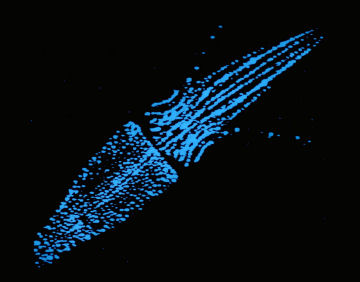 |
|
Creatures that live in the deep-sea, such as this squid, create a type of glowing bluish light called bioluminescence. Scientists are still trying to figure out how these animals see their watery world.
|
| Edith Widder |
A team of researchers recently made an 11-day expedition to the Bahamas to do just that. On the expedition, called Deep Scope 2007, the researchers used a deep-diving submersible, a special camera system, and other tools to try to see what deep-sea creatures see.
Their results are changing what we know about life in the dark depths of the sea.
A big place
Water covers most of the Earth, and the oceans are thousands of feet deep in most spots. Compared to forests, prairies, and other ecosystems, the deep sea is by far the largest type of environment on the planet where animals can live. So, if you want to understand Planet Earth, you have to understand its oceans.
Exploring the deepest parts of the sea, however, is challenging if you’re limited to the equipment that scientists have generally used for the task.
“What we’ve been doing is like driving a tank through Yellowstone [National] Park and hoping to see elk and bear,” says Edith Widder, a deep-sea biologist with the Ocean Research and Conservation Association in Fort Pierce, Fla. She was one of the leaders of the Deep Scope expedition.
Driving a tank through Yellowstone would not be a good way to spot wildlife because the park is huge, and noisy tanks scare animals away. Underwater, many animals have a similar reaction to loud, brightly lit submersibles and robotic vehicles.
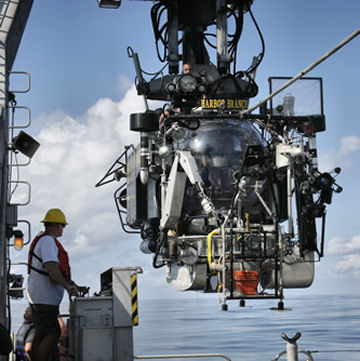 |
|
The ship’s crew retrieves a Johnson-Sea-Link II submersible after a full day of work in the Bahamas.
|
| Mark Schrope |
The Deep Scope team began its expedition with a tanklike submersible called the Johnson-Sea-Link II. The sub, which can carry two pilots and two observers, is owned by the Harbor Branch Oceanographic Institution in Ft. Pierce.
The Johnson-Sea-Link II allowed the researchers to explore the depths and watch deep-sea animals that were not scared away by the machine.
The sub even had a suction tube and robotic arm for collecting underwater creatures. The sub delivered these specimens to the team’s main ship on the ocean’s surface.
The group also used the submersible to drop off and pick up a special camera system called the Eye-in-the-Sea, or EITS. The system has a video camera inside a waterproof case. The camera sits on a metal tripod that is about 6 feet tall. It films with red light, which most deep-sea animals can’t see, so they don’t get scared away.
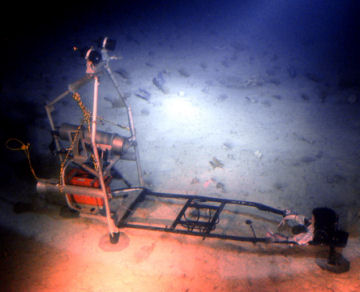 |
|
The Eye-in-the-Sea camera system allows scientists to begin to see what life is really like in the deep sea.
|
| Edith Widder |
During the Deep Scope 2007 expedition, Widder and graduate student Erika Raymond occasionally left EITS on the seafloor for a day at a time. They programmed the camera to record for 1 minute out of every 5 minutes, for a total of about 300 minutes a day.
Later, when the two researchers watched the tape, they yelped with joy every time they saw something interesting. Sometimes, for example, they cheered for a 12-foot-long sixgill shark that made occasional appearances.
Light shows
One of the biggest advantages of EITS is that it allows researchers to see how deep-sea creatures communicate with one another—using a type of light called bioluminescence.
Bioluminescent creatures use chemicals to make their own light. Though only a very few animals, such as fireflies (See “Firefly Delight”), do it above water, most animals in the ocean bioluminesce.
Scientists believe that sea creatures use this light for everything from scaring away predators to finding food in dark waters. But it’s been hard to say for sure what bioluminescence is for because scientists can’t spend much time in the deep sea.
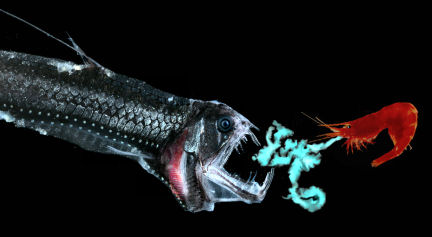 |
|
This illustration shows how a deep-sea shrimp might spew a cloud of bioluminescence to distract a viper fish and escape the predator’s hungry jaws.
|
| Edith Widder |
EITS can stay underwater a lot longer than scientists can. It also has a gadget on the front that lights up to look just like bioluminescence.
On the Deep Scope expedition, Widder and Raymond programmed the light system to flash in different patterns. They were ecstatic to find that when the lure flashed in certain ways, some animals flashed back.
Those flashes showed that for the first time, the scientists were actually “talking” to deep-sea creatures using light.
“We finally established a line of communication,” says Widder. However, it will take more research to figure out for sure what was said.
Seeing through their eyes
Before scientists can understand what animals are saying and doing with their bioluminescent light, they need to see the world as the animals see it.
 |
|
CAPTION: Researchers Edith Widder and Erika Raymond analyze video recorded by the EITS camera system during the recent Deep Scope expedition.
|
| Mark Schrope |
Scientists already know, for example, that most deep-sea animals can see only blue light. There is very little sunlight in the deep sea, but bioluminescent light is everywhere. And bioluminescence is almost always bluish.
Based on this knowledge, Sönke Johnsen, from Duke University in Durham, N.C., who’s also a Deep Sea leader, is changing colors in photos taken from the submersible to look like what deep-sea animals actually see.
To human eyes, for example, a red deep-sea crab sticks out against the background of the seafloor. But if your eyes could see only blue light, bright red would look black. Many of the rocks and rubble on the sea floor would also look black.
 |
|
This image shows three views of the same animal—a deep-sea crab. Human eyes see the crab’s red color (left). To a deep-sea creature that can’t see red, however, the crab looks dark and camouflaged (middle). Blurry vision, common in deep-sea animals (right), makes the crab even more difficult to see.
|
| Sönke Johnsen |
Studies have shown that many deep-sea critters also have blurry vision. So, a crab that’s easy for us to see can actually be invisible to a blurry-eyed sea predator.
“These guys sit on coral rubble everywhere,” says Johnsen. “And when they do, it’s almost perfect camouflage.”
The Deep Scope and other scientists have also learned that animals living in open water at the top 3,000 feet of the ocean light up their undersides. This makes them blend with the sunlight so they are hidden from hungry predators below.
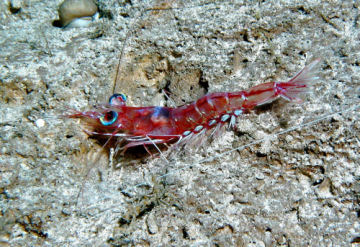 |
|
Scientists still have a lot to learn about the vision of deep-sea creatures, like this shrimp.
|
|
Tammy Frank
|
Though biologists have learned a lot about what creatures live in the deep and what they do or don’t see, they still have many questions. For example, scientists want to know how bioluminescence is used, how often animals light up, and what creatures of the ocean depths remain to be discovered.
To help, Widder, Raymond, and others are working on a new version of EITS that will be placed permanently in a deep-sea canyon off the Monterey Bay Aquarium Research Institute in California. The system, to be installed early next year, will run 24 hours a day. And the scientists plan to ask students to help them review all that video footage.
So, if you want to be a deep-sea explorer, stay tuned!
Going Deeper:







